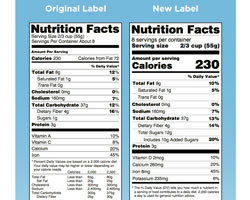New food label changes aim to better inform consumers
Changes to the Nutrition Facts label will include more relevant information, such as calories per serving and added sugar. Released: June 2, 2016
Released: June 2, 2016
MANHATTAN, Kan. – Many Americans, now more than ever, are concerned about the ingredients in their food. New changes to the food label by the U.S. Food and Drug Administration aim to lessen their concerns, as the changes highlight calories per serving as well as the amount of sugar added by the manufacturer.
Sandy Procter, Kansas State University assistant professor of food, nutrition, dietetics and health, said she is looking forward to the changes.
“This change in the Nutrition Facts label is a long time coming,” Procter said. “We’re looking forward to having an improved source of information on food so consumers can make a more intelligent choice.”
Procter, also a K-State Research and Extension nutrition specialist and registered dietitian, said that the new label will be easier to read, as the print will be larger. Now the number of calories per serving will jump out at consumers to make them more aware of how many calories a serving, or a full package, actually contains.
Added sugar is another item on the new food label. Currently, the label only shows how much sugar is in the food, but this can be misleading.
“A lot of foods have natural sugar in them; case in point is milk,” Procter said. “The sugar in milk, lactose, is considered part of the total sugar, but it certainly isn’t added sugar. We don’t consider it something that is going to be damaging to the diet.”
Another example, Procter said, is orange juice. The new added sugar line under “Total Sugars” will help consumers easily see the difference between 100 percent fruit juice and sugary alternatives.
Along with changes in the way calories and sugar are listed on the label, the way vitamins are presented will change.
“Vitamin A and vitamin C are still important nutrients, but in the U.S., we get ample amounts of those in our diets for the most part,” Procter said. “So, those two nutrients are coming off the Nutrition Facts label and being replaced by two that are identified in the Dietary Guidelines for Americans 2015-2020 as nutrients of concern, those being potassium and vitamin D.”
The changes aim to make it easier for consumers to decide what is healthy for them. Putting more relevant information on the label and making it easier to read gives consumers a better idea of what is actually in the food, the expert said.
“We know that obesity, diabetes and weight-related health problems are some of the most threatening that the world has to tackle,” Procter said. “Those public health problems need public health solutions, and this is a great step in helping the consumer to easily be able to make those decisions at the point of sale.”
These changes don’t go into effect immediately, however. Manufacturers are allowed a short time to make the necessary changes to their product labels.
“There are about two years until (the new labels) are enforced,” she said. “If a company has less than $10 million dollars in revenue, it may have a year longer than that. The change is not intended to be a burden on a company, so the changes are not mandated to happen overnight. I expect to see some companies move to these guidelines relatively soon though, because they’ve been proposed for quite a while now.”
It’s important to note that these changes do not apply to meat, poultry and processed egg products, Procter said, as the U.S. Department of Agriculture regulates those products.
For more information, visit the FDA website or any local extension office in Kansas.
-30-
K-State Research and Extension is a short name for the Kansas State University Agricultural Experiment Station and Cooperative Extension Service, a program designed to generate and distribute useful knowledge for the well-being of Kansans. Supported by county, state, federal and private funds, the program has county Extension offices, experiment fields, area Extension offices and regional research centers statewide. Its headquarters is on the K-State campus, Manhattan.
Story by:
James Schmidt
jtschmidt@ksu.edu
K-State Research and Extension
For more information:
Sandy Procter – procter@ksu.edu or 785-532-1675
